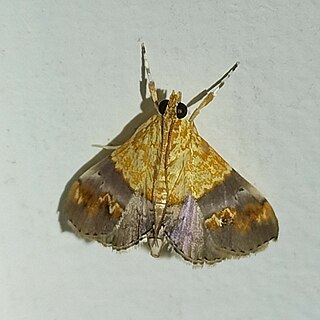
The Pyralidae, commonly called pyralid moths, snout moths or grass moths, are a family of Lepidoptera in the ditrysian superfamily Pyraloidea. In many classifications, the grass moths (Crambidae) are included in the Pyralidae as a subfamily, making the combined group one of the largest families in the Lepidoptera. The latest review by Eugene G. Munroe and Maria Alma Solis retain the Crambidae as a full family of Pyraloidea.

The Pyraloidea are a moth superfamily containing about 16,000 described species worldwide, and probably at least as many more remain to be described. They are generally fairly small moths, and as such, they have been traditionally associated with the paraphyletic Microlepidoptera.

Etiella zinckenella, the pulse pod borer moth, is a moth of the family Pyralidae. It is found in southern and eastern Europe and in the tropics and subtropics of Africa and Asia. They have also been introduced to North America and Australia. It is usually a minor pest for many legumes, but can be a serious pest.
Anaclastis is a genus of moths of the family Crambidae. It contains only one species, Anaclastis apicistrigellus, which is found in Australia, where it has been recorded from Queensland and New South Wales.
Analcina is a monotypic genus of moths of the Cybalomiinae subfamily of the Crambidae. It contains only one species, Analcina penthica, which is found in Australia, where it has been recorded from Queensland.
Nyctiplanes is a genus of moths of the family Crambidae. It contains only one species, Nyctiplanes polypenthes, which is found in Australia, where it has been recorded from Queensland.

Parapoynx fluctuosalis or Fluctuating China-mark or Waved China-mark, is a moth of the family Crambidae. It is a widespread species, known from Africa, India, Sri Lanka, China, Japan, Malaysia, Taiwan, Guam, Hawaii, Fiji, Australia and the Galápagos Islands. It is also an introduced species in Europe, where it has been recorded from Great Britain, the Iberian Peninsula and Sardinia.

Pyralis manihotalis is a moth of the family Pyralidae described by Achille Guenée in 1854.
Theila siennata is a moth in the family Crambidae. It was described by Warren in 1896. It is found in Australia, where it has been recorded from Queensland.
Phanomorpha icelomorpha is a moth in the family Crambidae. It was described by Turner in 1908. It is found in Australia, where it has been recorded from Western Australia.
Scoparia emmetropis is a moth in the family Crambidae. It was described by Turner in 1915. It is found in Australia, where it has been recorded from New South Wales.
Scoparia ithyntis is a moth in the family Crambidae. It was described by Turner in 1922. It is found in Australia, where it has been recorded from New South Wales and Victoria.
Scoparia melanoxantha is a moth in the family Crambidae. It was described by Turner in 1922. It is found in Australia, where it has been recorded from Queensland.

Tetracona amathealis is a species of snout moth in the subfamily Spilomelinae of the family Crambidae. It was described by Francis Walker in 1859 based on material collected at Moreton Bay in Queensland, Australia. It is found in New Guinea and Australia, where it has been recorded in Queensland, northern New South Wales and Western Australia. The species was formerly placed in the genus Agrotera, but in a recent taxonomic revision it was transferred back to the re-instated genus Tetracona, of which it is the type species.
Herpetogramma stultalis is a species of moth in the family Crambidae. It was described by Francis Walker in 1859. It is found in Malaysia, India, Sri Lanka, China, Japan, Pakistan, Papua New Guinea and Australia, where it has been recorded from Queensland. In Africa, it has been recorded from the Democratic Republic of the Congo and Réunion.

Pachynoa xanthochyta is a moth in the family Crambidae. It was described by Turner in 1933. It is found in Australia, where it has been recorded from Queensland and Asia.

Patania symphonodes is a species of moth in the family Crambidae. It was described by Turner in 1913. It is found in Australia, where it has been recorded from Queensland.
Sedenia atacta is a moth in the family Crambidae. It is found in Australia, where it has been recorded from South Australia.
Sedenia cervalis is a moth in the family Crambidae. It is found in Australia, where it has been recorded from South Australia and New South Wales.
Sufetula alychnopa is a moth in the family Crambidae. It was described by Turner in 1908. It is found in Australia, where it has been recorded from Queensland.







